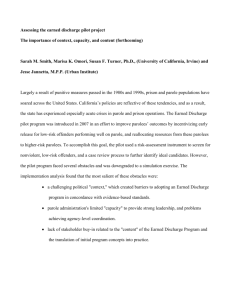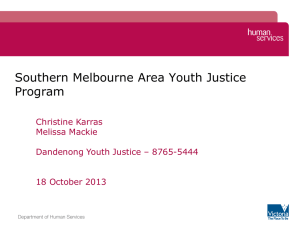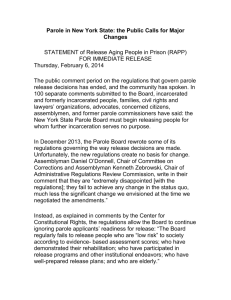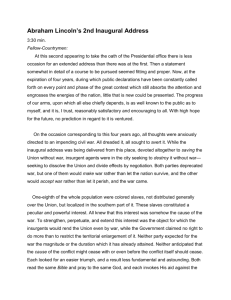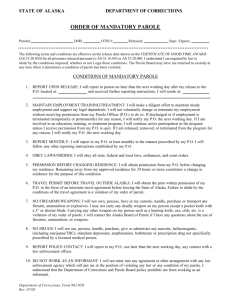Determining your parole eligibility
advertisement
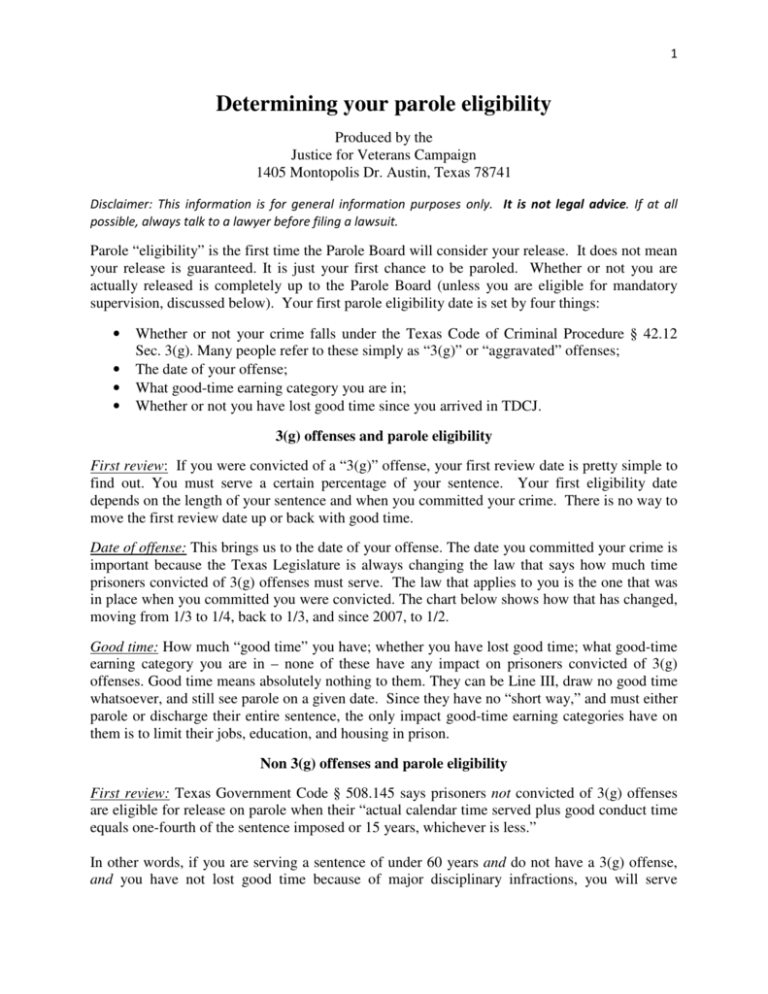
1 Determining your parole eligibility Produced by the Justice for Veterans Campaign 1405 Montopolis Dr. Austin, Texas 78741 Disclaimer: This information is for general information purposes only. It is not legal advice. If at all possible, always talk to a lawyer before filing a lawsuit. Parole “eligibility” is the first time the Parole Board will consider your release. It does not mean your release is guaranteed. It is just your first chance to be paroled. Whether or not you are actually released is completely up to the Parole Board (unless you are eligible for mandatory supervision, discussed below). Your first parole eligibility date is set by four things: • • • • Whether or not your crime falls under the Texas Code of Criminal Procedure § 42.12 Sec. 3(g). Many people refer to these simply as “3(g)” or “aggravated” offenses; The date of your offense; What good-time earning category you are in; Whether or not you have lost good time since you arrived in TDCJ. 3(g) offenses and parole eligibility First review: If you were convicted of a “3(g)” offense, your first review date is pretty simple to find out. You must serve a certain percentage of your sentence. Your first eligibility date depends on the length of your sentence and when you committed your crime. There is no way to move the first review date up or back with good time. Date of offense: This brings us to the date of your offense. The date you committed your crime is important because the Texas Legislature is always changing the law that says how much time prisoners convicted of 3(g) offenses must serve. The law that applies to you is the one that was in place when you committed you were convicted. The chart below shows how that has changed, moving from 1/3 to 1/4, back to 1/3, and since 2007, to 1/2. Good time: How much “good time” you have; whether you have lost good time; what good-time earning category you are in – none of these have any impact on prisoners convicted of 3(g) offenses. Good time means absolutely nothing to them. They can be Line III, draw no good time whatsoever, and still see parole on a given date. Since they have no “short way,” and must either parole or discharge their entire sentence, the only impact good-time earning categories have on them is to limit their jobs, education, and housing in prison. Non 3(g) offenses and parole eligibility First review: Texas Government Code § 508.145 says prisoners not convicted of 3(g) offenses are eligible for release on parole when their “actual calendar time served plus good conduct time equals one-fourth of the sentence imposed or 15 years, whichever is less.” In other words, if you are serving a sentence of under 60 years and do not have a 3(g) offense, and you have not lost good time because of major disciplinary infractions, you will serve 2 approximately 1/8 of your sentence before your first parole review. For example, if you have a 20-year sentence (240 months), lose no good time, and you are earning the maximum good time – 30 days for every 30 days you serve – you will be eligible for parole in 30 months (two and one-half years). Date of offense: This doesn’t matter for initial parole eligibility. Any person convicted of a non3(g) offense prior to Sept. 1, 1987, had to do 1/3 of his sentence and no more than 20 yearss, before parole eligibility. All of those prisoners have already become eligible and are now eligible for parole. The date of your offense only matters for release on mandatory supervision, which is different.*. Good time: For someone serving a 20 year sentence, if you avoid major cases, you will be eligible after serving 1/8 (or 2.5 years) of your sentence because your flat time plus your good time will total 1/4 of your sentence. But if you pick up a major case and are dropped into and stay in Line Class III, drawing no good time, you will do 1/4 of your sentence in flat time before your first review date. In other words, if you are doing a 20-year sentence, (240 months) you will serve five years before becoming eligible for parole if you are not earning good time. So, on the same 20-year sentence, you can serve anywhere between two-and-a-half to five years before becoming eligible, all because of your good time. Losing good time, and your class status (and the ability to earn good time), are important to determine when you can see parole for non-3(g) prisoners. Basically, you are at the mercy of the TDCJ to promote you, grant you good time, and then determine your first parole review date. Following the rules and staying out of trouble is the best way to make sure you are eligible for parole as quickly as possible. Parole Eligibility Chart Offense Date Prior to 09/01/77, Between 09/01/77 and 08/31/87 Offense Type all prisoners were eligible for parole when calendar time plus good time equaled 1/3 of their sentence. .. Aggravated Kidnapping All other offenses Aggravated Robbery Maximum – 20 years before parole Aggravated Sexual Assault eligible Capital Murder 1/3 flat time plus good time Or any offense with an affirmative finding of a Deadly Weapon, To be parole eligible, you must serve: Minimum – 2 years Maximum – 20 years 1/3 calendar time (without good time) Between 09/01/87 and 08/31/89 3(g) offense, which include Aggravated Kidnapping Aggravated Robbery Aggravated Sexual Assault Any offense with Affirmative finding of Deadly Weapon Capital Murder All other offenses Maximum – 15 years before parole eligible 1/4 flat time plus good time 3 To be parole eligible, you must serve: Minimum – 2 years Maximum – 15 years 1/4 calendar time (without good time) Between 09/01/89 and 08/31/93 Capital Offense with a Life Sentence To be parole eligible, you must serve: 35 flat years (without good time) All other offenses Maximum – 15 years before parole eligible 1/4 flat time plus good time For all of the 3(g) Offenses listed above, to be parole eligible, you must serve: Minimum – 2 years Maximum – 15 years 1/4 flat time (without good time) Between 09/01/93 and 08/31/95 Capital Offense with a Life Sentence To be parole eligible, you must serve: 40 flat years (without good time) All other offenses Maximum – 15 years before parole eligible 1/4 flat time (plus good time) For all the 3g Offenses listed above, including the following: Indecency w/Child (Sexual Contact)2nd Degree Murder, 1st Degree To be parole eligible, you must serve: Minimum – 2 years Maximum – 30 years 1/2 calendar time (without good time) Between 09/01/95 and 08/31/97 Capital Offense with a Life Sentence To be parole eligible, you must serve: 40 flat years without good time All other offenses Maximum – 15 years before parole eligible ¼ flat time plus good time 4 Aggravated Kidnapping (with intent to violate or abuse the victim sexually Aggravated Sexual Assault Burglary of Habitation with Intent to commit any of the following sexual offenses Aggravated Sexual Assault Indecency w/Child Possession or Promotion of Child Pornography Prohibited Sexual Conduct Sexual Assault Sexual Performance by a Child AND you are serving a life sentence AND you have a prior conviction for any of the above-listed offenses To be parole eligible, you must serve: 35 flat years without good time For all the 3g Offenses listed above, including the following: Sexual Assault (of a Child) To be parole eligible, you must serve: Minimum – 2 years Maximum – 30 year ½ flat years without good time Between 09/01/97 and 08/31/2005 Capital Felony To be parole eligible, you must serve: 40 years flat time (without good time) For the above listed offenses, AND you are serving a life sentence AND you have a prior conviction for any of the above-listed offenses You must serve 35 flat years (without good time) All other offenses Maximum – 15 years before parole eligible 1/4 flat time plus good time 5 For all the 3g Offenses listed above, including the following: Indecency w/Child (Sexual Contact)2nd Degree Sexual Assault, *all subsections To be parole eligible, you must serve: Minimum – 2 years Maximum – 30 years 1/2 flat time (without good time) Between 09/01/2005 and 08/31/2007 Capital Felony You are ineligible for parole For the above listed offenses, including the following: Burglary of Habitation with Intent to Commit any of the following listed sexual offenses: Obscenity (images of child under the age of 18) AND you are serving a life sentence AND you have a prior conviction for any of the above-listed offenses You must serve 35 flat years without good time All other offenses Maximum – 15 years before parole eligible 1/4 flat time plus good time For all the 3(g) Offenses listed above To be parole eligible, you must serve: Minimum – 2 years Maximum – 30 years 1/2 flat time (without good time) From 09/01/2007 to present OF Capital Felony You are ineligible for parole For any of the offenses listed above AND you are serving a life sentence AND you have a prior conviction for any of the above-listed offenses To be parole eligible, you must serve: 35 flat years (without good time) For all the 3g Offenses listed above, including the following: Injury to a Child or Elderly or Disabled Individual, 1st Degree (applies only to Child victim 14or younger) Murder, 1st Degree Sexual Performance by a Child -43.25, All other offenses Maximum – 15 years before parole eligible 1/4 flat time plus good time 6 all subsections To be parole eligible, you must serve: Minimum – 2 years Maximum – 30 years 1/2 flat time without good time * Mandatory supervision was created in September of 1977. Prior to that, all prisoners had to be released, without any supervision whatsoever, when their earned good time plus served flat time added up to their total sentence. Between 1977 and 1987, all prisoners were still released when their flat time plus their good time added up to their sentence, but they were subject to supervision and had to comply with whatever restrictions the Board of Pardons and Paroles applied to them. For prisoners convicted after September 1, 1987, Texas began denying release on mandatory supervision to prisoners convicted of 3(g) and certain other offenses. What this essentially did was nullify any positive effect of good time for these prisoners – they either made parole or discharged their entire sentences. That nullification was extended to all prisoners after September 1, 1996, by the creation of Discretionary Mandatory Supervision, which gave the parole board the right to deny release on mandatory supervision to any prisoner if the board thought that prisoner posed a “continuing threat” to the public. (Source: Parole in Texas – Answers to common questions. Published by the Texas Board of Pardons and Paroles and the Texas Department of Criminal Justice Parole Division, 2012. Accessed at http://www.tdcj.state.tx.us/bpp/publications/publications.html)

